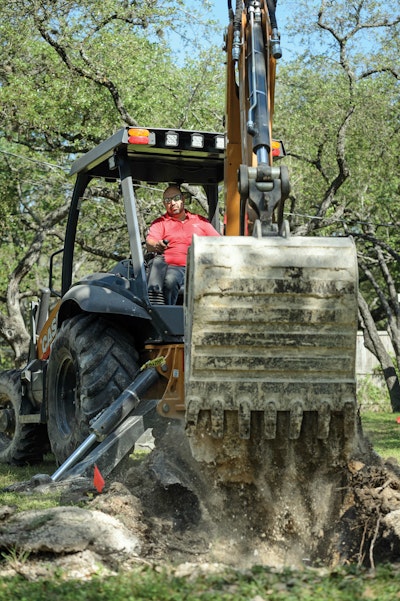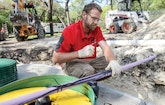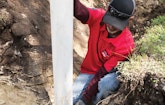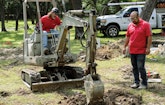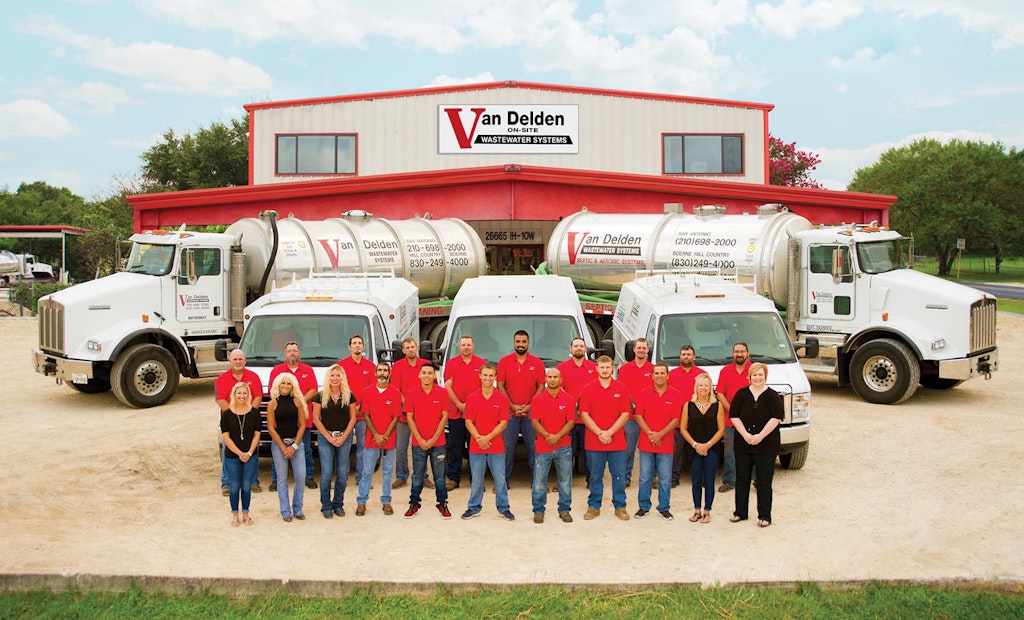
The team at Van Delden Wastewater Services stands with equipment at the company headquarters. (Courtesy of Van Delden Wastewater Services)
A lot has changed in the past 10 years for Van Delden Wastewater Systems.
Chad Van Delden and his sister Courtney Van Delden have taken ownership as their parents, Garrett and Pam Van Delden, retired. Yellow Pages have given way to diverse online marketing. New service management software has integrated the essential business functions. The workforce has grown, and onsite installations are now booked three to six months out as the company contracts with builders to serve entire new subdivisions.
What hasn’t changed at all is Van Deldens’ dedication to comprehensive onsite service, quality work and customer satisfaction.
The company, first profiled in Onsite Installer in May 2010, now has 22 team members, plus Garrett and Pam, who still help in their retirement years. Based in Boerne (pronounced “Bernie”), Texas, about 30 miles northwest of San Antonio, the fourth-generation business includes thriving installation, septic system pumping and aerobic system maintenance divisions.
Long history
The company’s roots go back 83 years to Chad and Courtney’s great-grandfather, Frank Van Delden. He was succeeded by son Gary, whose son Garrett came on board in 1977. Twenty years later, Garrett and Pam bought the business, then called Van Delden Service Co. Courtney joined the firm in 2003 and Chad in 2006. Since taking over, they have aggressively modernized operations while winning new customers with an old-fashioned work ethic.
Chad runs the installation division, while Courtney runs the pumping and aerobic divisions and the office operation, which has expanded in recent years. The pumping side now has four vacuum trucks, and a fifth may be needed soon.
The company’s market territory has expanded. “The economy is better off around the nation than it was 10 years ago,” Courtney observes. “The area where our office is located has boomed. There’s a stoplight at our corner, where before it was a country highway. Population growth has been exponential, and that has led to more business for us.”
Some of the new subdivisions and other with larger lots are being built on septic systems.
Boerne used to be a small town unto itself. It is now home to about 16,000 residents and essentially blends with San Antonio.
Tech solutions
Growth in business has been a key motivator for taking the operation digital. One ongoing project, started nearly two years ago, involves scanning paper files and service work orders dating back to 1974. “We didn’t have enough wall space anymore to accommodate file cabinets,” Courtney says. “Every year we were adding more cabinets, and it was not sustainable. We still have at least a couple of years of scanning left.”
More important is the digitization of business processes. Late last year the company went live with ServiceTitan software, which has integrated work orders, scheduling, dispatching and invoicing. Field team members now carry tablets instead of paper business forms. “The program tracks our technicians so we’re able to know just by looking at the screen if they are on their way to the next job, if they’ve arrived and how long they’ve been there,” Courtney says. “We’re able to track their progress throughout the day.”
Meanwhile, a program called Verizon Connect provides tracking for the vacuum trucks, service vans and installation vehicles. “On the pump trucks, we can track the PTO and the time the pump is on and off. It tracks their speed, and we get notices of hard brakes and hard accelerations so we can keep on top of safe driving.”
The field technicians were thoroughly trained in the ServiceTitan program and went through a pilot testing phase. “They were very receptive to it and excited about it,” Courtney says.
“We’ll be quicker to complete work orders, generate invoices and get them out to our customers than we were able to be with paperwork.
“It’s a big change for us in a good way. We don’t have all that paperwork to process, and we have a more efficient way to keep track of everything. We’ll have more time to work on expanding our services.”
Growth trajectory
Business expansion has never been a problem. The installation side has taken a leap in recent years. Chad observes, “For the past five years, we’ve had contracts for full subdivisions. We’ve always done subdivisions, but not every lot. Now we have contracts with builders where we pretty much have the whole neighborhood.”
That business grew largely from word-of-mouth, but also through builders locating the company’s website and reading reviews and ratings. “Then they interviewed us and we got the contracts,” Chad says. Typically, the subdivisions include 75 to 80 homes.
“Our main thing is catering to the builders, keeping them happy and responding fast to any requests they have,” Chad says. “The builders work with a lot of contractors, and it can be a challenge getting in and out with everybody in the way. We try to be very responsive. Timeliness is a huge thing for them.”
Aerobic treatment units are increasingly prevalent because the area’s high limestone bedrock is not hospitable to conventional drainfields. “In the old days, you could install conventional systems in rock,” Chad says. “Nowadays you can’t. Probably less than 5% of the properties we serve get conventional systems.”
Breaking rock
Equipment on the installation side includes a 2011 Bobcat 630 skid loader, a 1999 CASE skid loader, four CASE 580 backhoes (models years 1999 to 2018), two hoe ram hydraulic rock breaker backhoe attachments, a 2006 Ditch Witch trencher with a rock saw, a Takeuchi mini-excavator, five Ford pickup trucks and a Ford flatbed truck.
Two crews install the first phase; the third crew does the second phase. “The first phase is tank installation, and it basically consists of a day or two of rock hammering to install the tank and sewer line,” Chad says. “We have 2,000-pound rock breaker attachments for our backhoes. The second phase includes the electrical wiring and the spray heads.”
The company installs ATUs from Clearstream Wastewater Systems. Secondary-treated effluent is delivered to a pump tank from which it is sent during night hours to strategically placed spray heads triggered by a timer. “We design the spray area to accommodate future pools, patios and other amenities that homeowners will likely build,” Chad says.
Sprays irrigation fields typically require 4,000, to 5,000 square feet and are best suited to lots half an acre and larger. On smaller lots where older conventional systems are failing, drip irrigation systems are the preferred solution.
Keep 'em running
Van Delden Wastewater Systems does a strong business in maintaining Clearstream systems, including some installed by other companies. That includes pumping of the tanks. “Around here, we have companies that just do installation, or just aerobic maintenance, or just pumping,” Chad says. “We’re trying to pick up the pumpings on brands for which we don’t do service.”
To service ATUs, a technician visits three times a year to perform a complete system check. Four Ford service vans are equipped with all the basic maintenance tools including a Sludge Judge (TG Wastewater), drill, ohmmeters and amp meters.
Courtney says, “They are fully stocked so the technicians can address whatever is needed at any job site they go to. The vans carry pumps and aerators, plus all the pipes, fittings and filters — everything that’s needed for regular maintenance and service. They should be able to take care of everything while they are there.”
The pumping fleet includes three Kenworth T800s (2017, 2016 and 2007), each with a 4,000-gallon aluminum tank and Masport 400XL pump, and a 1997 Freightliner with a 3,600-gallon aluminum tank and Jurop/Chandler pump.
“All our vacuum truck operators have been with us for a long time,” Courtney says. “They’re good at what they do, and they provide good customer service.” If the tank location isn’t obvious, the operators use probes or, in the most challenging cases, a metal detector or a Prototek locator with a flushable transmitter.
“When we pump, we’re not just pumping out the liquids,” Courtney says. “We pump out everything. In the past year, we’ve started using Crust Busters on every job. That helps us break down the heavy solids and get the tank pumped out efficiently. Sometimes the trash compartments of aerobic tanks are buried. We always dig those up and make sure we pump out everything from the system.”
Septage disposal is increasingly expensive, as the local wastewater treatment plants tend to raise their rates each year. Dump sites are a San Antonio Water System plant located 45 minutes from the office and a land application site that’s about an hour away. To regulate costs, the drivers try to dump when relatively close to one site or the other.
Marketing online
While the company still advertises in neighborhood newsletters and through postcards, marketing has gone largely digital. It includes Google AdWords for pay-per-click advertising, as well as a presence on Angie’s List, Facebook and a Nextdoor website and app. “We check reviews on those sites often and respond quickly to any negative ones,” Courtney says. “Everybody looks at reviews these days.”
A refurbished website launched in 2012 has helped with search engine optimization and has brought in substantial traffic. Education blog posts on the website — typically two to four per month — help keep the company prominent in prospective customers’ internet searches. “Anytime I get a question from a customer that I haven’t addressed before, I bring that question to the blog and answer it,” Courtney says. “We feel that the more our customers are educated, the better off they’re going to be.”
Education also extends to the field. Chad observes, “After system replacements, we educate the owners on what the aerobic system is since they may or may not be familiar with the technology. When I do an estimate, I explain what an aerobic system is, and after it’s installed, we do an orientation with the homeowner. The orientation book has a diagram and a copy of questions. We show them how the alarm works and show them the spray area.”
Courtney adds, “For the builders, once a system is completed and we know who the homeowner is, we do the orientation for all the aerobic installations. We’re going to service that system, and we want to be sure everyone is on the same page.”
A quality team
Keeping it all together is an experienced and well-qualified team. Chad says, “A challenge across the industry is finding people who want to do this kind of work and are good at it. When we find them, we want to keep them.
“We pay the pumpers and technicians well. On the aerobic maintenance side, we hire people who have some electrical experience and can troubleshoot and diagnose all the mechanical components. On the pumping side, we train people well to locate the tanks and do a good, professional job.”
Courtney adds, “We have high standards, but we’re also easy to get along with. Usually once a quarter we schedule some sort of company outing or event. For the past five years, we’ve had a day where we take all the technicians to a lake. They get paid for the day and have a chance to bond and have fun. We do that for our office staff, as well. We give Christmas bonuses. We try to provide a nice place to work.”
Sticking with one ATU
Van Delden Wastewater Systems of Boerne, Texas, installed its first aerobic treatment unit in 1990. Today the company installs about 80 ATUs per year, all of them from Clearstream Wastewater Systems.
“About 80% of them are the 600-gpd 600NC3T models,” Chad Van Delden says. “The rest are 600NU, 750N and 1000N units. Clearstream has been around since the beginning of aerobic systems, and they are one of the most popular and well-respected brands.”
Courtney Van Delden adds, “We installed our first aerobic system before they started being regulated in Texas in 1997. We had to convince the county to let us install one. When aerobic systems started coming out in other areas of the country, our parents did their research on the brands. They even went to the manufacturers to check them out.
“We started with Clearstream, and we have never wanted to change. One thing I like about them is that we have the flexibility to put the control box and aerator on the side of the house, rather than having a preset unit where those items are sticking out in the customer’s yard. They are aesthetically appealing.”
The supply source is convenient since Clearstream is headquartered in Beaumont, about five hours away, and it has a plant and sales outlet in Johnson City, about an hour away from the Van Delden Wastewater Systems office.
